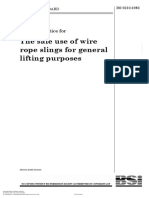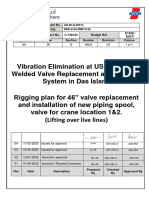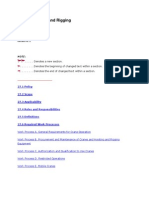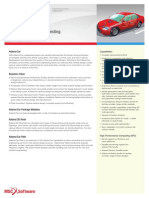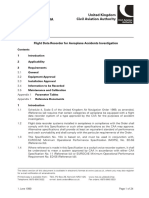Proof Testing Whitepaper v1.0
Proof Testing Whitepaper v1.0
Uploaded by
hshobeyriCopyright:
Available Formats
Proof Testing Whitepaper v1.0
Proof Testing Whitepaper v1.0
Uploaded by
hshobeyriOriginal Title
Copyright
Available Formats
Share this document
Did you find this document useful?
Is this content inappropriate?
Copyright:
Available Formats
Proof Testing Whitepaper v1.0
Proof Testing Whitepaper v1.0
Uploaded by
hshobeyriCopyright:
Available Formats
Aa
straightpoint
WHITEPAPER
SUPPORT INFORMATION
PROOF TESTING
Proof Testing – Straightpoint v.1.0
Proof Testing
Technical White Paper
David Mullard – Business Development Manager Straightpoint
March 2017
Abstract
This article looks at the practicalities of proof testing, whilst identifying areas for
improvement and providing a more effective and proportionate approach to equipment
inspection. It also discusses ways to increase traceability without making the process
more onerous.
It was written upon completion of an extensive research programme related to the launch
of new software, Proof Test plus (or SW-PTP), that adds speed, accuracy and breadth to
data recording and certification related to non-destructive load verification or proof load
testing. However, this white paper is not exclusively related to that technology or the
Radiolink plus load cells, load shackles or compression load cells that gather data for it.
CONTENTS
What is a proof test ………………………………………………………………………… iii
Standards for North America ……..……………………………………………………….. iv
What equipment is proof tested ……..……………………………………………………. v
How to proof test …………………………………………………………………………… v
Why proof test ………………………………………………………………………………. v
Not always required …..……………………………………………………………………. vi
Proof testing equipment ……………………………………………………………………. vii
Proof Testing ‐ Straightpoint ii
Proof Testing
What is a proof test?
In its simplest form, load testing involves applying a load to a structure or piece of equipment. A proof test
is a type of load test that demonstrates the fitness of a load‐bearing structure. Such tests may be required
as part of a thorough examination in line with Lifting Operations and Lifting Equipment Regulations 1998
(LOLER) that place duties on people and companies who own, operate or have control over lifting
equipment.
LOLER places emphasis on the experience of a competent person, who makes an informed decision as to
what is appropriate based on their training. They determine if a proof test is necessary or helpful to assess a
piece of lifting equipment.
A proof test is usually expressed as a percentage of the working load limit (WLL) that equipment is designed
to withstand.
The exact requirements of proof testing and the extent of each test can vary depending on standards,
equipment or industries involved, as well as individual requirements from customers or as part of
manufacturers’ own quality controls.
Lifting equipment manufacturers may carry out proof tests routinely or as a batch test in line with their own
QA/QC procedures, but for goods for sale in the EU a minimum requirements is that of the Machinery
Directive.
The Machinery Directive 2006/42/EC section 4.1.2.3 addresses the static and dynamic tests that must be
performed on all lifting machinery ready to be put into service. These tests help satisfy the ‘fitness for
purpose’ requirement of lifting machinery or lifting accessories discussed in section 4.1.3.
The Directive also states (line 20) that for certain types of machinery having a higher risk factor, a stricter
certification procedure is desirable. A few examples of additional certification standards that may require
load testing include:
BS EN 14439: references proof of strength and stability of cranes, including out of service stability to
account for wind loading.
EN12079 and DNV2.7‐1 standards set minimum criteria for design, material, production and testing
of containers used in offshore applications, with specific guidance on proof testing.
Maritime industries ‐ Proof load testing is required for almost all lifting appliances and loose lifting
gear in order to obtain Lloyds register certification. Other verification bodies such as Det Norske
Veritas (DNV) and Bureau Veritas have similar requirements for lifting gear.
Proof Testing ‐ Straightpoint iii
Standards for North America
There, proof load testing is performed to meet a number of standards predominantly set out by the
following bodies:
OSHA — Occupational Safety and Health Administration
ASME — The American Society of Mechanical Engineers
ANSI — American National Standards Institute
A few examples of standards that may require load tests to be performed on lifting equipment and
accessories include:
ASME B30.9: on lifting slings
ASME B30.10‐1.7: on hooks
ASME B30.16: on overhead hoists (underhung)
ASME B30.17: on overhead and gantry cranes and trolleys
ASME B30.20: various below‐the hook lifting devices
ASME B30.20: for manual lever hoists
ASME B30.26: for various lifting accessories: shackles, eyebolts, turnbuckles, links, rings, swivels and
compression hardware.
OSHA Section 1926.251(a)(4) covers special custom design lifting accessories that shall be proof‐tested
prior to use to 125% of WLL.
ANSI N14.6: application specific for special lifting devices for shipping containers for nuclear materials
weighing >4500kg.
Again, in mission critical industries, additional tests may be required. NASA for example specifies the
occasions and frequency of proof load tests and periodic load tests to be performed on lifting devices and
equipment (LDE’s) in its NASA‐STD‐8719.9 technical standard on lifting.
Proof Testing ‐ Straightpoint iv
What equipment is proof tested?
At the most basic level this could be any equipment or structure that lifts, holds, supports or resists a load.
Typically the item will have a rated WLL, as mentioned previously.
Here are some non‐exhaustive examples:
Bollard pull tests
Tug tests
Crane tests (using water bags, block weights)
Pad eye or fly point tests
Crash barrier tests
Lifting equipment tests (slings, chains, wire rope, hooks)
Construction equipment tests (shoring columns, Acrow props, lintels)
Lifting and spreader beam tests
Hydraulic cylinder load tests
Some of those items will be proof tested in tension, for example, slings, chains, wire rope and cranes, while
others will be tested in compression, for example, Acrow props, spreader beams and hydraulic cylinders.
How to proof test?
Numerous load‐testing applications worldwide require a load cell to verify the load applied, from crane
testing using water bags and a tension load link to cylinder testing using a hydraulic test rig and a
compression load cell.
A load cell allows the test to be accurately measured and recorded. In safety critical industries the
requirement to document test procedures and results has never been greater as users of lifting equipment
call for more traceability and audit trails.
Why proof test?
A proof test ensures a lifting item works correctly and safely through its full cycle operation. In most cases,
visual inspections often tell a lifting equipment engineer very little. One cannot tell the condition of the
internal working parts or the history of the item. An old crane may be visually unappealing but perfectly
maintained and in great working order versus a brand new crane that was heavily overloaded on its first use
and is internally damaged. In the case of the latter, a visual inspection would be pointless.
Ask oneself, how does a user know the crane is structurally and mechanically sound without imposing a
proof load on the machine? How do they check that the winch brake can hold the required line pull? How
can they check that the boom hoist clutch is not slipping or the hydraulic lock valves or cylinder seals are
not passing oil, without imposing the maximum load they are expected to carry?
Proof Testing ‐ Straightpoint v
Clearly, putting the equipment under load allows the competent person to complete a full assessment by
watching and listening to the lifting equipment during operation. Thus, many engineers have a load link
available to perform a load test on site.
To achieve the same level of assurance of no failures at capacity without a proof test would require an even
deeper inspection schedule to compensate. The machine may need to be stripped down and inspected
piece by piece, perhaps with non‐destructive testing (NDT) being carried out on individual parts. Specific
service intervals would need to be introduced to ensure regular replacement of parts based on hours in use
and number of cycles.
According to Safety Assessment Federation (SAFed) figures, the five million equipment examinations
conducted by its member companies each year identify a significant number of safety‐related defects of up
to 5% depending on equipment type. With this level of detection, a reduction in the scope or periodicity of
examination is not advisable without alternative risk control measures.
Not always required
Even as a manufacturer of force measurement, load monitoring and suspended weighing load cell
equipment, Straightpoint recognises that routine proof testing is not always beneficial and needs to be
carried out as part of a broader assessment. Regular inspection, servicing schedules and replacement of
parts based on hours of use / number of cycles are all alternatives and complementary activities to support
safe lifting.
As the UK’s Health & Safety Executive (HSE) states, routine load testing isn’t a requirement. In a document
titled, ‘Thorough examinations and inspections of lifting equipment’, it says, ‘Most lifting equipment does
not need routine testing as part of the thorough examination—in fact some overload tests can cause
damage to lifting equipment. Where testing is deemed necessary, it may not need be undertaken at every
thorough examination. The need for, and nature of, testing should be based on an assessment of risk—
taking account of information from the manufacturer and other relevant information—as determined by
the competent person.’
Proof Testing ‐ Straightpoint vi
Proof testing equipment
Straightpoint manufactures a variety of equipment that can be used for proof testing. As referenced at the
outset, its Proof Test plus (or SW‐PTP) software records data gathered by a Radiolink plus load cell, load
shackle or compression load cell. It then creates a pass or fail certificate that includes test data and graphs
charting data from the load versus time throughout a test.
Information can be printed out directly as a PDF report, electronically transmitted or fed to an information
centre in the cloud. It is important that there is traceability of proof test certification and that the load cell
that did the test was accurate and calibrated. Where a load test is deemed beneficial the aim of Proof Test
plus is to make that process more efficient.
Proof Testing ‐ Straightpoint vii
Proof Testing – Straightpoint v.1.0
You might also like
- Cargo Net l3 Ast Le Adma 314Document6 pagesCargo Net l3 Ast Le Adma 314Anwar DeenNo ratings yet
- OMHEC Maintenance Lifting AppliancesDocument18 pagesOMHEC Maintenance Lifting AppliancesLasse WelleNo ratings yet
- BS 6210.1983 C P The Safe Use of Wire Rope Slings For General Lifting PurposesDocument26 pagesBS 6210.1983 C P The Safe Use of Wire Rope Slings For General Lifting PurposesAriq Fauzan0% (1)
- Ohs - PR-19-F10 (A) Chain Block InspectionDocument1 pageOhs - PR-19-F10 (A) Chain Block Inspectionshagufta100% (1)
- Introducing The LEEADocument2 pagesIntroducing The LEEAMinesh EnginerNo ratings yet
- Information Sheet No 1 LOLER and Rope Access HS 242ENGDocument13 pagesInformation Sheet No 1 LOLER and Rope Access HS 242ENGSakthi VelNo ratings yet
- Draft T& T LOLER RegulationsDocument68 pagesDraft T& T LOLER RegulationsDerron SoogrimNo ratings yet
- Technical-Guides Shackle Inspection Spa 2003Document1 pageTechnical-Guides Shackle Inspection Spa 2003israel11288No ratings yet
- Practical Structural Examination of Container Handling Cranes in Ports and TerminalsDocument17 pagesPractical Structural Examination of Container Handling Cranes in Ports and TerminalsStella SofiaNo ratings yet
- Bendi B55 AC Operators HALF SIZE Manual F-595-R1Document82 pagesBendi B55 AC Operators HALF SIZE Manual F-595-R1ИванNo ratings yet
- Rigging Awareness Program: Saudi Aramco: Company General UseDocument54 pagesRigging Awareness Program: Saudi Aramco: Company General UseVenkata Surya Nagendra Rao SesettyNo ratings yet
- LEEA-062-14 Guidance To The Development of Chain Sling Instructions For Use - Version 1 - Jan 16Document12 pagesLEEA-062-14 Guidance To The Development of Chain Sling Instructions For Use - Version 1 - Jan 16ahmadNo ratings yet
- The Complete LOLER Regulations Manual: Chase House, 16 The Parks, Newton-le-Willows, WA12 0JQDocument12 pagesThe Complete LOLER Regulations Manual: Chase House, 16 The Parks, Newton-le-Willows, WA12 0JQGaniyuNo ratings yet
- Wire Rope Inspector: Target GroupDocument1 pageWire Rope Inspector: Target Groupegy pureNo ratings yet
- Inspection, Through Examination and Testing of Lifting Appliance and Lifting GearDocument33 pagesInspection, Through Examination and Testing of Lifting Appliance and Lifting GearSaif Rehman100% (1)
- Iso 9927 3 2019Document12 pagesIso 9927 3 2019athahabimNo ratings yet
- LEEA Correspondence Courses: Assignment 1.2Document3 pagesLEEA Correspondence Courses: Assignment 1.2Primelift Safety Resources Limited0% (1)
- Unpriced PoDocument2 pagesUnpriced PoNiti YuangyimNo ratings yet
- Crane/lifting Operations Supervisor: Planning and Regulatory RequirementsDocument5 pagesCrane/lifting Operations Supervisor: Planning and Regulatory RequirementssurendraNo ratings yet
- Lifting Crew RegisterDocument10 pagesLifting Crew RegisterMohd FadliNo ratings yet
- Crane Wire Rope Code PDFDocument1 pageCrane Wire Rope Code PDFraulbrlunaNo ratings yet
- Hoists Kito CB PDFDocument11 pagesHoists Kito CB PDFVenu GopalNo ratings yet
- Slings 1910 184 Occupational SafetyDocument12 pagesSlings 1910 184 Occupational SafetyJosé Pablo Espinoza SolísNo ratings yet
- List of Wire Rope SlingsDocument1 pageList of Wire Rope SlingskvsagarNo ratings yet
- NO. Sample Question Andrei's Answers: Max, MarkDocument5 pagesNO. Sample Question Andrei's Answers: Max, MarkAndrei100% (1)
- LEEA Correspondence Courses: Assignment 1.10Document6 pagesLEEA Correspondence Courses: Assignment 1.10ikponmwonsaNo ratings yet
- Cica GN 0001 A Wind Guidance NoteDocument3 pagesCica GN 0001 A Wind Guidance Noteconsulting2No ratings yet
- ICOP AGN 0002 Anchor Strengths 1Document3 pagesICOP AGN 0002 Anchor Strengths 1PhilNo ratings yet
- Iso 4305 1991Document8 pagesIso 4305 1991Juca GianniniNo ratings yet
- Crane Splice 24 Instructions For UseDocument20 pagesCrane Splice 24 Instructions For Usenasif andriantoNo ratings yet
- Simple Guide To The Lifting Operations and Lifting Equipment Regulations 1998Document8 pagesSimple Guide To The Lifting Operations and Lifting Equipment Regulations 1998salesgglsNo ratings yet
- Exam 5Document6 pagesExam 5huy phamNo ratings yet
- Inspection Rigging EquipmentDocument1 pageInspection Rigging Equipmentwahyu haryadiNo ratings yet
- QEN-P118 Lifting ProcedureDocument12 pagesQEN-P118 Lifting ProcedureMauro MLRNo ratings yet
- Best Practice Transport of TubularsDocument11 pagesBest Practice Transport of TubularsANDREYNo ratings yet
- Rigging - ICE Level 3 - 01 07 14Document5 pagesRigging - ICE Level 3 - 01 07 14Dak KaizNo ratings yet
- Final Revision On Mechanics For Final Exam 2017 21-05-43Document97 pagesFinal Revision On Mechanics For Final Exam 2017 21-05-43mohamed sabryNo ratings yet
- MSC.1-Circ.1318-Rev.1 - PDF (IMO Circular 1318 CO2 Maintenance) 4Document9 pagesMSC.1-Circ.1318-Rev.1 - PDF (IMO Circular 1318 CO2 Maintenance) 4AbuBakarSiddiqueNo ratings yet
- AD 90 G 00513 Rev.04Document47 pagesAD 90 G 00513 Rev.04Wajid Ahmed100% (1)
- Crane MasterlistDocument4 pagesCrane MasterlistMohd FadliNo ratings yet
- Lifting AppliancesDocument24 pagesLifting AppliancesAlexanderNCNo ratings yet
- Operation and Maintenance Manual - RAM2Document45 pagesOperation and Maintenance Manual - RAM2Mario JanžetićNo ratings yet
- Thorough Examination of Lifting Tables: GuidelineDocument11 pagesThorough Examination of Lifting Tables: Guidelineairdrop makrotestNo ratings yet
- GL Pers Transfer Basket Inspection PDFDocument26 pagesGL Pers Transfer Basket Inspection PDFSteve Morrison100% (1)
- Webbing Slings WillemDocument6 pagesWebbing Slings WillemRamchandraNo ratings yet
- Rigger Level 3 New Sagar ChiliveriDocument13 pagesRigger Level 3 New Sagar Chiliveriusman.farooq700No ratings yet
- As 3585-2008 End Fittings For Synthetic Flat-Webbing and Round SlingsDocument7 pagesAs 3585-2008 End Fittings For Synthetic Flat-Webbing and Round SlingsSAI Global - APAC0% (1)
- Experience List For Third Party Inspection of Lifting Equipment / RacksDocument14 pagesExperience List For Third Party Inspection of Lifting Equipment / Racksshahbaz akramNo ratings yet
- SAIC-U-7011 - Jib & Monorail Cranes-2023Document6 pagesSAIC-U-7011 - Jib & Monorail Cranes-2023محمد ممدوحNo ratings yet
- Saic-U-7002 - Below-The Hook Lifting Equipment (Lifting-Spreader Beams) - 2023Document3 pagesSaic-U-7002 - Below-The Hook Lifting Equipment (Lifting-Spreader Beams) - 2023محمد ممدوحNo ratings yet
- SAF 358 Management and Colour Coding of Lifting EquipmentDocument21 pagesSAF 358 Management and Colour Coding of Lifting EquipmentDjim. NOUBARANo ratings yet
- Rci BS 7262Document3 pagesRci BS 7262Rizwan AhmedNo ratings yet
- Indg290 - A Simple Guide To LOLERDocument8 pagesIndg290 - A Simple Guide To LOLERDarko Zovko100% (1)
- Cranes Hoisting and RiggingDocument25 pagesCranes Hoisting and Riggingkanakarao1No ratings yet
- Indian Inovatix Safety Products CatalogueDocument42 pagesIndian Inovatix Safety Products CatalogueIndian Inovatix LimitedNo ratings yet
- Wire Rope DesignationDocument4 pagesWire Rope DesignationResshille Ann T. SalleyNo ratings yet
- Scaffolding Construction Part 1 ChecklistDocument6 pagesScaffolding Construction Part 1 ChecklistAbdullah Al-gherairy100% (1)
- Stablization Standards For Outrigger MatsDocument2 pagesStablization Standards For Outrigger MatsMikeNo ratings yet
- The Handbook of Safety Engineering: Principles and ApplicationsFrom EverandThe Handbook of Safety Engineering: Principles and ApplicationsRating: 4 out of 5 stars4/5 (1)
- 2016 Crosby General Catalog English Imperial McKissick SheavesDocument12 pages2016 Crosby General Catalog English Imperial McKissick SheaveshshobeyriNo ratings yet
- Electrical Conductivity LeafletDocument2 pagesElectrical Conductivity LeaflethshobeyriNo ratings yet
- Accumulators in Drilling FlyDocument1 pageAccumulators in Drilling FlyhshobeyriNo ratings yet
- QSP-3.1-1-Form 01 Application for Certification (Revision 10)Document2 pagesQSP-3.1-1-Form 01 Application for Certification (Revision 10)hshobeyriNo ratings yet
- Lubricants 10 00337Document19 pagesLubricants 10 00337hshobeyriNo ratings yet
- DSA - Tender Doc-TechnicalDocument1 pageDSA - Tender Doc-TechnicalhshobeyriNo ratings yet
- M Farahani CV - n3Document2 pagesM Farahani CV - n3hshobeyriNo ratings yet
- A Strategic Management Model For Evaluation of Health, Safety and Environmental PerformanceDocument12 pagesA Strategic Management Model For Evaluation of Health, Safety and Environmental PerformancehshobeyriNo ratings yet
- Gas Hydrates, As Future Energy and Safety in Its Operation: Amir BadakhshanDocument32 pagesGas Hydrates, As Future Energy and Safety in Its Operation: Amir BadakhshanhshobeyriNo ratings yet
- DSA - TenderDocument1 pageDSA - TenderhshobeyriNo ratings yet
- DSA - Tender Doc-FinancialDocument1 pageDSA - Tender Doc-FinancialhshobeyriNo ratings yet
- Load Test ProcedureDocument70 pagesLoad Test ProcedurehshobeyriNo ratings yet
- 2222 PDFDocument13 pages2222 PDFhshobeyriNo ratings yet
- 6102 PDFDocument1 page6102 PDFhshobeyriNo ratings yet
- 3214Document8 pages3214hshobeyriNo ratings yet
- The Place of Data, Smart Data Structures and Data Analysis in HSE Risk Assessment, Management and TransferDocument1 pageThe Place of Data, Smart Data Structures and Data Analysis in HSE Risk Assessment, Management and TransferhshobeyriNo ratings yet
- Drillstring & BHA DesignDocument36 pagesDrillstring & BHA DesignJim BodeNo ratings yet
- Well Control School BookletDocument21 pagesWell Control School BooklethshobeyriNo ratings yet
- Consequences of Process Events Evaluation in The Shahid Tondgoyan Petrochemical Company Using PHAST SoftwareDocument14 pagesConsequences of Process Events Evaluation in The Shahid Tondgoyan Petrochemical Company Using PHAST SoftwarehshobeyriNo ratings yet
- South Pars Field Development Project Phase Two & Phase ThreeDocument125 pagesSouth Pars Field Development Project Phase Two & Phase ThreehshobeyriNo ratings yet
- Rig Inspection & SurveyDocument102 pagesRig Inspection & Surveyhshobeyri100% (1)
- Report 1 by Prof Maurice Dusseault and DR Baldeo Singh 6-1Document26 pagesReport 1 by Prof Maurice Dusseault and DR Baldeo Singh 6-1hshobeyriNo ratings yet
- Guages & Measurment Tools Inventory and ControlDocument24 pagesGuages & Measurment Tools Inventory and ControlhshobeyriNo ratings yet
- 1 (2) - Pdfplot11.hdi 11.0.55.0 - 002328Document2 pages1 (2) - Pdfplot11.hdi 11.0.55.0 - 002328Jesson Diaz VicenteNo ratings yet
- Calibration Guide T71 EN 80253037Document2 pagesCalibration Guide T71 EN 80253037Servicio TécnicoNo ratings yet
- Ms28777 Rev DDocument2 pagesMs28777 Rev DMathew UsfNo ratings yet
- Panel ATS AMF 2000ADocument1 pagePanel ATS AMF 2000AJD JayNo ratings yet
- Fileupload 1381940945Document8 pagesFileupload 1381940945Cim HanoiNo ratings yet
- SRS APO Panel ReadmeDocument25 pagesSRS APO Panel ReadmeLiz Minmey Flores FloresNo ratings yet
- 1.relation Between Torsion Moment, Torsion Angle and Span LengthDocument15 pages1.relation Between Torsion Moment, Torsion Angle and Span LengthMoiz Amir100% (1)
- Questionnaire For DistributorDocument5 pagesQuestionnaire For DistributorhemantdongreNo ratings yet
- AdamsCar DSDocument0 pagesAdamsCar DSOvidiu DanielNo ratings yet
- EPEVER Datasheet Tracer An (10A 4OA)Document2 pagesEPEVER Datasheet Tracer An (10A 4OA)Amien HajaNo ratings yet
- Business Process Reference ModelsDocument88 pagesBusiness Process Reference ModelsLohith KumarNo ratings yet
- C ProgrammingDocument138 pagesC Programmingarunkumar_a8131No ratings yet
- Uma Unimaster 70 250 Dust CollectorsDocument12 pagesUma Unimaster 70 250 Dust Collectorsmartc35No ratings yet
- No Fault Found Policy: Supplier Support ManagementDocument14 pagesNo Fault Found Policy: Supplier Support ManagementfcoppenholleNo ratings yet
- En 7000 05038 PDFDocument32 pagesEn 7000 05038 PDFthienvvNo ratings yet
- Cost Comparison Between Foundry ProcessesDocument1 pageCost Comparison Between Foundry ProcessesSiraj PatelNo ratings yet
- 3 BQDocument322 pages3 BQTian Yu100% (1)
- Rotational Motion Engineering Mechanics IIT KanpurDocument67 pagesRotational Motion Engineering Mechanics IIT KanpurNitin SharmaNo ratings yet
- Autodesk Inventor 2015 Courses Contents by Serer N - Anglocad.Document9 pagesAutodesk Inventor 2015 Courses Contents by Serer N - Anglocad.Nikola ŠererNo ratings yet
- Knauf LN Waferhead ScrewsDocument2 pagesKnauf LN Waferhead ScrewsAmir SohailNo ratings yet
- VLSM ExerciseDocument3 pagesVLSM ExercisevsbbwnNo ratings yet
- Design For Communities: F 4.4 Alternative Grid LayoutDocument4 pagesDesign For Communities: F 4.4 Alternative Grid LayoutaditNo ratings yet
- Y4 HL Autumn Block 1 Place Value 2020Document7 pagesY4 HL Autumn Block 1 Place Value 2020طالبة العلم طالبة العلمNo ratings yet
- Inovasi Rumah SakitDocument17 pagesInovasi Rumah Sakitfreteer100% (1)
- DPA5 User Manual PDFDocument61 pagesDPA5 User Manual PDFAlan Wear100% (1)
- MasterLife WP 730 - TDSDocument3 pagesMasterLife WP 730 - TDSabukayes.abdinNo ratings yet
- 2531 User Manual English+Spanish PDFDocument22 pages2531 User Manual English+Spanish PDFbogdan110675% (4)
- 1 s2.0 S1350630712002403 Main PDFDocument13 pages1 s2.0 S1350630712002403 Main PDFFrancesco MontagnoliNo ratings yet
- Optical Pyrometer: Prepared By: 3 Class E/C Banatanto, Peter John Ej FDocument23 pagesOptical Pyrometer: Prepared By: 3 Class E/C Banatanto, Peter John Ej FPeter John Ej BanatantoNo ratings yet
- Specification No. 10A United Kingdom Civil Aviation AuthorityDocument24 pagesSpecification No. 10A United Kingdom Civil Aviation AuthorityblackhawkNo ratings yet


